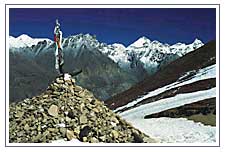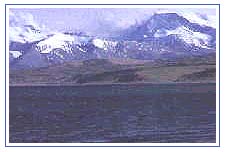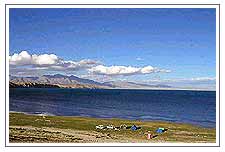| Mount Kailash & Mansarovar Yatra | ||
| Location: | Western Region Of Tibet, Tibetan Himalayas |
| Duration: | 30 Days |
| Highest Altitude: | 6,675m |
| Best Time To Visit: | June To September |
The Path To Nirvana:
The majestic Himalayas figure prominently not only in the topography of India
but in its history and mythology as well. The youngest mountain range in the world,
and yet the mightiest, the Himalayas are many things to many people.
Mount Kailash
 Mount Kailash, which is believed to have been formed 30 million years ago when Himalayas were in their early stage of formation, is one of the most revered places in the Himalayas.
Mount Kailash, which is believed to have been formed 30 million years ago when Himalayas were in their early stage of formation, is one of the most revered places in the Himalayas.Spread out on the Tibetan plateau beside Mount Kailash is the giant lake of shifting colours - Lake Mansarovar. Brahma, the creator, had a mind (‘Man’) for the creation of a lake (‘Sarovar’), hence its name. A pilgrimage to Mount Kailash and a bath in the Mansarovar is believed to bring about salvation (Moksha).
About The Kailash Mansarovar Yatra
People have been visiting Kailash - Mansarovar for centuries. Almost all the
major passes of Uttaranchal Himalayas lead to Kailash - Mansarovar.
The important ones in the Kumaon region are Lipulekh, Lampiya Dhura,
Nuwe Dhura, Lowe Dhura, Unta Dhura, Jayanti and Kungri Bingri. Since 1981,
under the auspices of the Indian ministry of external affairs and with the
cooperation of the Chinese government, Kumaon Mandal Vikas Nigam
has been conducting trips to Kailash - Mansarovar through the Lipulekh pass.
The number of people allowed visiting Kailash - Mansarovar is limited and
it is hoped that in the near future, more Indian pilgrims will be allowed to
visit Western Tibet, the region of sacred mountains and lakes.
Legends, Myths & Beliefs
Legends, Myths & Beliefs

It is because of Kailash - Mansarovar, which is 865-kms from Delhi, that Kumaon is sometimes called “Manaskhand”. Many myths are associated with this unusual mountain and lake. The Buddhists, the Jains and the Bonpas of Tibet too, all revere this spot with great fervour and devotion. Therefore, it is not surprising for a devotee to come across the worlds “Om Mani Padme Hum” (“Hail to the jewel (of Creation) in the Lotus) written on stones and taken from Buddhist scriptures. The Bonpas make an anti-clockwise pilgrimage around Mt. Kailash whereas the believers of the jain faith specially visit astpaad near the southern face of kailash in the kailash --mansarovar region.
Mansarovar Lake The circumference of Mansarovar is 88-km, its depth is 90m and total area is 320-sq-kms. The lake freezes in the winters and melts only in spring. It looks unbelievably fascinating on moonlit nights when an ethereal ambience pervades the atmosphere. The circumference of Rakshas Tal, also known as “Ravan Kund”, is 122-km. A 6-km long natural channel - “Gangachhu” - connects Manas with Rakshas Tal.
The circumference of Mansarovar is 88-km, its depth is 90m and total area is 320-sq-kms. The lake freezes in the winters and melts only in spring. It looks unbelievably fascinating on moonlit nights when an ethereal ambience pervades the atmosphere. The circumference of Rakshas Tal, also known as “Ravan Kund”, is 122-km. A 6-km long natural channel - “Gangachhu” - connects Manas with Rakshas Tal.
Mansarovar Lake
 The circumference of Mansarovar is 88-km, its depth is 90m and total area is 320-sq-kms. The lake freezes in the winters and melts only in spring. It looks unbelievably fascinating on moonlit nights when an ethereal ambience pervades the atmosphere. The circumference of Rakshas Tal, also known as “Ravan Kund”, is 122-km. A 6-km long natural channel - “Gangachhu” - connects Manas with Rakshas Tal.
The circumference of Mansarovar is 88-km, its depth is 90m and total area is 320-sq-kms. The lake freezes in the winters and melts only in spring. It looks unbelievably fascinating on moonlit nights when an ethereal ambience pervades the atmosphere. The circumference of Rakshas Tal, also known as “Ravan Kund”, is 122-km. A 6-km long natural channel - “Gangachhu” - connects Manas with Rakshas Tal.
No comments:
Post a Comment